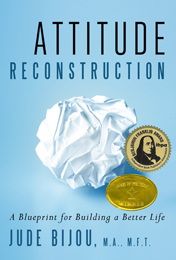People whose most dominant emotion is fear are easy to recognize. In general, we are the “speedy ones,” focused on time and money. We feel that there’s never enough. We tend to be worriers — scattered, confused, overwhelmed, dramatic, panicky, or controlling. If you ask us, we will tell you that peace is something that’s elusive.
Do some of these tendencies ring a bell for you? If so, and if you’re tired of feeling like that, here are four easy ways to chill out according to Attitude Reconstruction. Almost instantly, you’ll reduce the amount of fear you feel and experience more peace of mind.
1. Shiver the fear out of your body rather than tightening up.
Emotions are just pure physical sensation in your body. So allow yourself to physiologically express the fear you feel rather than tightening up. When I feel nervous, jumpy, agitated, or my mind is racing a million miles an hour, I let my body do what’s natural. I vigorously shiver, shudder, and shake all over, like a dog at the veterinarian. Though it can seem weird, silly, or contrived at first to jiggle, shiver, tremble, and let my knees knock, I almost immediately feel more relaxed, centered, and able to focus. When I can’t sleep at night, need to return a scary telephone call, or make a presentation, I duck into the bathroom, shiver for just a minute or two, and remind myself: “It’s okay to feel scared. I just need to shiver.” The result is almost miraculous. This one simple activity has to restore calm and bring you back to the present. Give it a try!
2. Interrupt thoughts about the future and past, and avoid over-generalizations.
To keep things manageable and in perspective, keep bringing yourself back to the present. And be specific about the concerns at hand, rather than generalizing about your whole life, your relationship history, your character, the world, and so on. The words “always” and “never” fuel fear. Likewise, bringing other unresolved issues into the specific topic you’re grappling with is like putting gasoline on the barbecue. It makes reaching a satisfactory resolution nearly impossible. I highly recommend that, over and over, you tell yourself reassuring things. Many times a day, repeat whichever of these phrases will be most supportive: “Everything will be all right. Everything is all right. One thing at a time. Everything is unfolding in its own time. I’ll handle the future in the future. Be here now. Stay specific.”
3. Break big projects into a series of simple little pieces, and attend to one thing at a time.
The key to managing fear and life’s tasks is to take the time daily to get organized. For each task you need to accomplish, start by articulating your goal. With that in mind, break the goal into a series of little doable steps. Make each step small enough so you know you can do it. If you keep an ongoing list of exactly what needs to be done by when, you can evaluate what’s most important and essential for today. I put my to-do list in an obvious place by the computer so I can see it. Then I just do what’s next, and offer myself copious praise for each small victory.
4. In terms of lifestyle choices, strive to establish a regular, more relaxing routine.
Get more sleep. Don’t miss meals. Cut down on the coffee and energy drinks. Stay out of cold, damp, and drafty places. Reduce the amount of stimulation you expose yourself to. You’ll feel better if you spend time engaging in less frightening or anxiety-producing activities, situations, movies, or games, and more time doing relaxing things, such as gentle walks, watching sunsets, and listening to calming music.
By following just a few of these simple suggestions, I’m certain you’ll gain major ground in balancing out your fear. Take a couple of baby steps daily. Especially, shiver when you revert back into that familiar fearful place, or anytime agitation overtakes your body. You’ll soon find that you enjoy whatever your day brings to you, and you’re able participate with more humor, ease, and equanimity.






